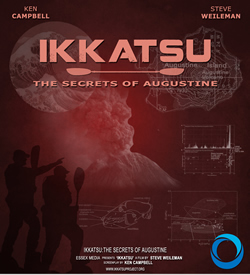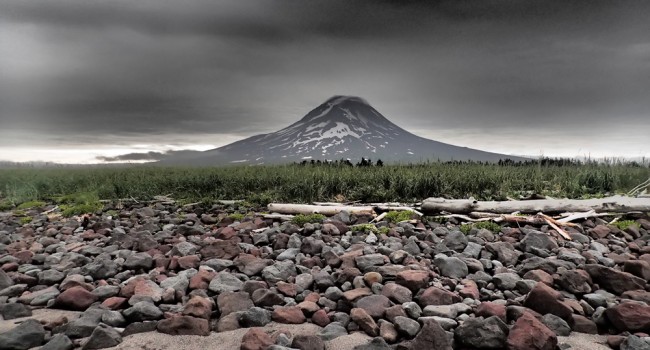
Secrets of Augustine
Kayaking and Science in Wild Alaska
Last year’s Roadless Coast expedition took the Ikkatsu Project team along Washington’s Olympic coastline where we surveyed remote beaches for marine debris. We had barely finished that trip when we decided to do another, this time to south-central Alaska, to see what might have washed up on some of the least-visited and wildest shorelines in Cook Inlet. We decided on Augustine, a volcanic cone near the mouth of the inlet, a remote island whose beaches had never been surveyed before and that, as far as we knew, hadn’t seen kayakers since the days of baidarkas and sea otter hunts.
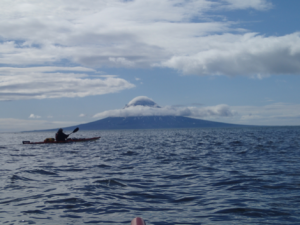 Planning for the trip took the better part of a year. We had a good idea of what we were getting into but we knew all along that there would be surprises as the expedition unfolded. It was often difficult, however, to see them coming. We had made a film the year before about our Washington trip and we were planning to do another. The working title for this year’s adventure was “The Secrets of Augustine.” We figured there would be some unknowns, some facts and realities that we hadn’t really considered, and there were. For example:
Planning for the trip took the better part of a year. We had a good idea of what we were getting into but we knew all along that there would be surprises as the expedition unfolded. It was often difficult, however, to see them coming. We had made a film the year before about our Washington trip and we were planning to do another. The working title for this year’s adventure was “The Secrets of Augustine.” We figured there would be some unknowns, some facts and realities that we hadn’t really considered, and there were. For example:
– Alaska is big. I mean, really big. It’s one thing to know that this is the case, but it’s quite another to be face-to-face with the fact for weeks at a time. The scale of the mountains, of the coastline, of distances, is completely overpowering, way out of human proportions. Just getting to Homer from Washington State took six days on the ferry. For the two weeks we were on the island, the only sign we had that we were not alone in the world was a single airplane that we saw briefly one afternoon.
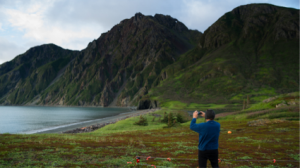 – There’s no arguing with the weather. Although we arrived at the island at the end of June, our first few days saw us with temperatures in the low 40’s and sustained winds of 35 knots and higher. The water near shore was whipped into a froth by the angry gusts and we spent more time walking than paddling. We listened to the weather reports every morning and afternoon, heard the glowing accounts of seventy degree-days in Anchorage and elsewhere around the last frontier, but because Augustine is situated where it is, it has a habit of catching all of the storms near the mouth of Cook Inlet. I played a fair bit of solitaire early on.
– There’s no arguing with the weather. Although we arrived at the island at the end of June, our first few days saw us with temperatures in the low 40’s and sustained winds of 35 knots and higher. The water near shore was whipped into a froth by the angry gusts and we spent more time walking than paddling. We listened to the weather reports every morning and afternoon, heard the glowing accounts of seventy degree-days in Anchorage and elsewhere around the last frontier, but because Augustine is situated where it is, it has a habit of catching all of the storms near the mouth of Cook Inlet. I played a fair bit of solitaire early on.
– Dead birds are hard to find. In addition to surveying beaches for marine debris, we were also hoping to examine beach-cast sea birds for evidence of plastic ingestion. We had practiced doing necropsies on specimens at the University of Puget Sound to prepare for the trip and we were working with Oikonos, a non-profit that specializes in sea bird issues, to develop a protocol that would allow for remote study of any birds we came across. But we didn’t find any; we suspect that, because of the preponderance of foxes, eagles and other scavengers, any bird remains that do make it to the beach don’t stay there for long.
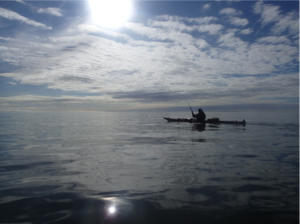 – Forget the tide – mornings are for paddling. Although the tide varied as much as twenty feet between low and high on some days, the winds were usually less of a factor in the mornings. We planned our on-water time for earlier in the day, regardless of what the tide was doing, which meant that our portages were often difficult and long. Our soul-crushing forced marches across what seemed like miles of sticky sand served to make the paddling easier perhaps, but at a significant cost to our legs and our psyches.
– Forget the tide – mornings are for paddling. Although the tide varied as much as twenty feet between low and high on some days, the winds were usually less of a factor in the mornings. We planned our on-water time for earlier in the day, regardless of what the tide was doing, which meant that our portages were often difficult and long. Our soul-crushing forced marches across what seemed like miles of sticky sand served to make the paddling easier perhaps, but at a significant cost to our legs and our psyches.
– It’s a big ocean, but it’s a small planet. Even here, at the top of the North Pacific Gyre and away from almost all other human experience, the beaches are fouled with plastic. It’s a sobering thought, that every piece of plastic that has ever been made is still in existence and it’s even more sobering to see so much of it in such a wild and primal place. Our biggest takeaway from this expedition is the knowledge that we have a responsibility to each other, to future generations and to the planet. There is no secret about that.
(This article originally appeared on the Canoe and Kayak Magazine web site, October, 2013.)

